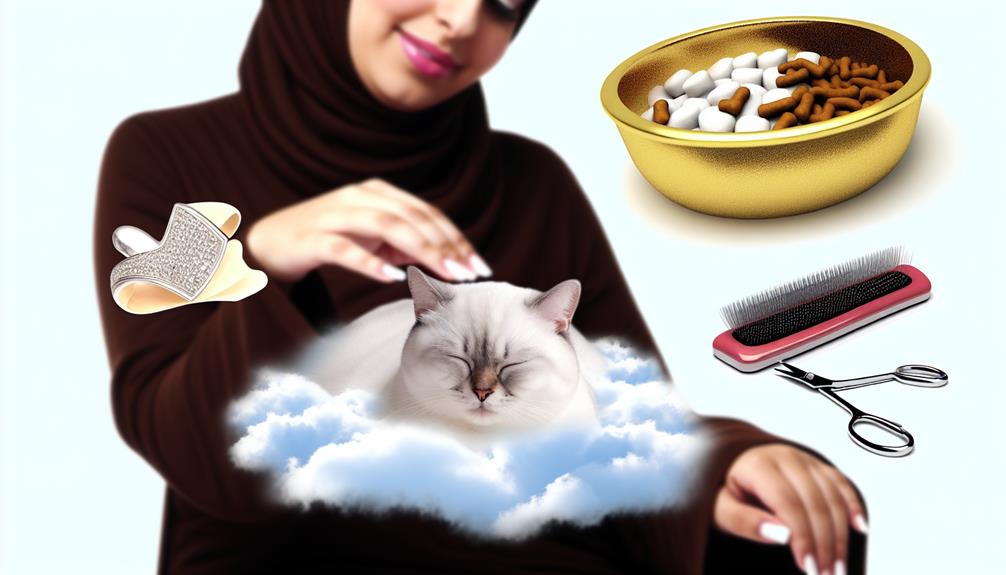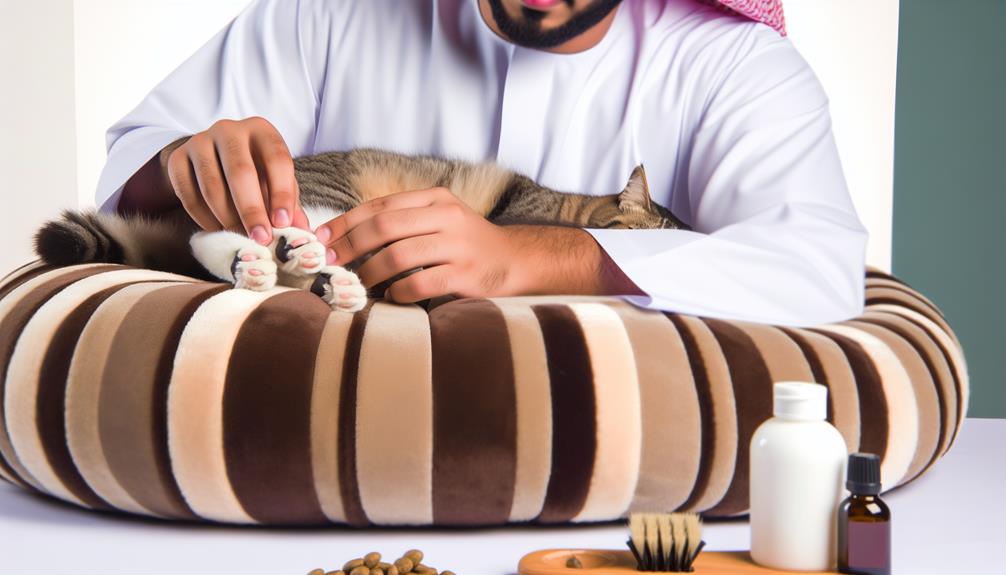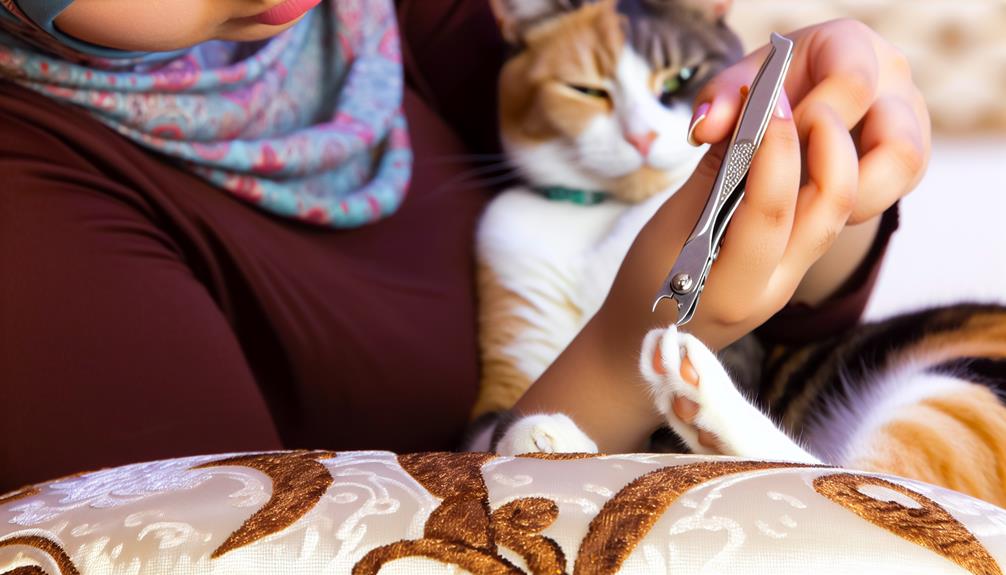When it comes to cutting your cat's nails, starting with the right approach can make all the difference. You've got to understand the basics of cat nail anatomy to avoid any mishaps, and choosing the proper tools is equally vital. It's not just about the clipping action; preparing your cat for the process is key to minimizing stress. Do you know the best way to handle and position your cat to guarantee a smooth trim? Let's explore the essential steps to make this routine a breeze for both you and your feline friend.
Understanding Cat Nail Anatomy
Understanding the anatomy of your cat's nails is vital before attempting any trimming. Each nail consists of a hard outer shell and a sensitive inner area called the quick. The quick contains nerves and blood vessels, making it important to avoid cutting into this area to prevent pain and bleeding. Observing your cat's nail structure will help you identify the quick, which generally appears as a pink or reddish area within the translucent part of the nail.
Your cat's nails grow in layers, a process known as nail growth. As new layers form, the outer layers shed naturally. Regular trimming helps manage this growth and prevents overgrown nails that can cause discomfort or health issues. Each nail has a natural curve, and the quick follows this curve closely, extending further in cats with lighter-colored nails where it's more visible. For cats with darker nails, extra caution is required as the quick is less discernible.
When examining your cat's nails, gently press the top of the paw to extend the nails. This allows you to study their structure and note the location of the quick. Familiarize yourself with the anatomy to build confidence and guarantee safe trimming sessions. Remember, patience and a gentle approach are key.
Safety should always be your priority. Improper trimming can lead to injuries or infections, so never rush the process. Understanding cat nail structure and nail growth will provide a solid foundation for maintaining your cat's nail health. By mastering these basics, you'll make nail trimming a stress-free experience for both you and your feline friend.
Choosing the Right Tools
Selecting the appropriate tools for trimming your cat's nails is fundamental to guarantee a safe and stress-free experience. The right tools will not only make the process smoother but also guarantee that you and your cat remain comfortable throughout. Let's start with the most essential item: nail clippers.
There are various types of nail clippers available, and choosing one suited for your cat is critical. Scissor-style clippers are often recommended for their precision and ease of use, particularly for novices. These clippers resemble small scissors and are ideal for cats with smaller nails. Guillotine-style clippers, on the other hand, require more skill but can provide a cleaner cut. Verify the blades are sharp; dull blades can crush rather than cut the nail, causing discomfort to your cat.
Safety is paramount, so consider investing in a pair with a built-in safety guard. This feature prevents you from cutting too much of the nail, reducing the risk of injuring the quick — the sensitive part of the nail containing blood vessels and nerves.
In addition to nail clippers, grooming gloves are highly beneficial. These gloves provide a better grip on your cat, making it easier to control their movements without causing them anxiety. The textured surface of grooming gloves also helps in calming your cat, as the sensation mimics petting. This can greatly reduce any stress or agitation during nail trimming.
Steps to Prepare Your Cat

Before you start trimming your cat's nails, it's vital to prepare them properly to guarantee a calm and safe experience. Understanding cat behavior and nail sensitivity will help you create a stress-free environment for your feline friend.
First, familiarize your cat with the nail trimming tools. Leave the clippers or scissors in a place they frequent, allowing them to sniff and examine the tools at their own pace. This helps reduce any fear or anxiety associated with the unfamiliar equipment.
Next, choose a quiet and comfortable space for the nail trimming session. Cats are sensitive to their surroundings, and a noisy or chaotic environment can heighten their stress levels. A calm setting will make the process smoother for both of you.
Handling your cat's paws regularly is essential. Gently press each paw to extend the nails, rewarding your cat with treats and praise. This desensitizes them to the sensation and makes them more comfortable with the process. It's significant to recognize that cats have varying levels of nail sensitivity, so proceed gently and observe their reactions.
Another key step is to tire out your cat before the session. Engage them in playtime to expend their energy, making them more relaxed and cooperative. This can notably reduce resistance and fidgeting during the trimming process.
Lastly, assess your cat's mood. Attempting a nail trim when they're agitated or hyperactive can lead to a negative experience. Wait until your cat is calm, perhaps after a meal or nap, to increase the likelihood of a successful session.
Proper Nail Trimming Technique
Proper nail trimming technique is essential for ensuring your cat's safety and comfort during the process. First, make sure you have a good-quality pair of cat nail clippers. Human nail clippers aren't suitable as they can cause splintering. Position your cat comfortably on your lap, ensuring they feel secure. Gently press the paw to extend the nails. Look for the quick, a pink area within the nail, which houses nerves and blood vessels; cutting into the quick can cause pain and bleeding.
When trimming, clip only the sharp, curved tip of the nail, avoiding the quick. A common nail trimming myth is that you need to cut the nails very short; however, trimming just the tip is sufficient for maintaining feline nail health. If you accidentally cut into the quick, have some styptic powder ready to stop any bleeding quickly.
Always use a confident but gentle grip, and speak soothingly to your cat. Remember, patience is key. If your cat gets too anxious, it's better to trim one or two nails at a time rather than forcing the issue. Regular, consistent trimming sessions will help your cat become more accustomed to the process.
It's vital to check all claws, including the dewclaws, which can sometimes be overlooked. Remember, maintaining a regular trimming schedule helps prevent nails from growing too long, which can lead to discomfort or injury.
Post-Trimming Care Tips

Once you've successfully trimmed your cat's nails, it's important to follow up with proper post-trimming care to guarantee your feline friend remains comfortable and healthy. Begin by offering post trimming rewards immediately after the session. Choose treats your cat loves or engage in a favorite activity like playtime. This positive reinforcement helps your cat associate nail trimming with pleasant experiences, making future sessions more manageable.
Next, inspect each paw for any signs of bleeding or discomfort. If you notice any bleeding, apply a styptic powder or cornstarch to the affected area to stop it. Make sure the area remains clean to prevent any potential infections. Monitoring your cat's behavior is crucial; if you observe excessive licking or limping, consult your veterinarian promptly.
Utilize soothing techniques to calm your cat post-trimming. Gently petting, brushing, or speaking softly to your cat can help reduce any stress or anxiety they may feel. Creating a relaxing environment with soft music or a quiet space can also be beneficial. It's important to give your cat time to adjust and feel secure after the trimming process.
In the days following the trim, keep an eye on your cat's paws and nails. Make sure there are no signs of redness, swelling, or unusual behavior. Regularly check the trimmed nails to guarantee they are growing back correctly and are not causing any issues. Consistent observation and care will help maintain your cat's overall paw health.
Conclusion
Properly trimming your cat's nails is essential for their well-being and can prevent injuries to both pets and owners. Did you know that 58% of cat owners report fewer scratches after regular nail trims? By understanding cat nail anatomy, choosing the right tools, preparing your cat, and using a safe trimming technique, you can make this routine stress-free and effective. Always remember to reward your cat post-trim to reinforce positive behavior and guarantee a safe, enjoyable experience for both of you.
